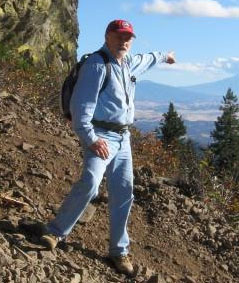SOU Grants Include Work at Cascade-Siskiyou National Monument

NEWS RELEASE
(Ashland, Ore.) — An emeritus professor of geology at Southern Oregon University has been awarded a pair of two-year grants for geologic work in Oregon – including one to help create special-purpose maps that show geologic features of the Cascade-Siskiyou National Monument.
 Jad D’Allura, Ph.D., a retired faculty member from the former geology department at SOU, received the grants in his capacity as an “adopted” member of the university’s Department of Chemistry – where he teaches the course, “Metals and Civilization (Ch 330)” each winter term.
Jad D’Allura, Ph.D., a retired faculty member from the former geology department at SOU, received the grants in his capacity as an “adopted” member of the university’s Department of Chemistry – where he teaches the course, “Metals and Civilization (Ch 330)” each winter term.
The first of the grants is a $15,500 award from the Bureau of Land Management, which is working through the non-profit group Friends of the Cascade-Siskiyou National Monument. The purpose is to support geologic mapping of the 86,774-acre Monument, which sits at the intersection of the Cascade, Klamath and Siskiyou mountain ranges and has an assortment of unique geologic features.
Work done under the 2016-17 grant will include placing data accumulated over the past 25 years into a usable Geographic Information System (GIS) format so that it can be used for planning and scientific purposes. The grant will also support the analysis of water samples for inorganic materials by a SOU chemistry student, who will be supervised by chemistry Professor Steven Petrovic.
The second, separate grant for $9,500 is from the Oregon Water Resources Department and will support geologic research on various geologic units. The work will help determine the effects of different geologic substrates on water flow and retention.
-SOU-
About Southern Oregon University
Southern Oregon University provides outstanding student experiences, valued degrees, and successful graduates. SOU is known for excellence in faculty, intellectual creativity and rigor, quality and innovation in connected learning programs, and the educational benefits of its unique geographic location. SOU was the first university in Oregon—and one of the first in the nation—to offset 100 percent of its energy use with clean, renewable power. It is the first university in the nation to balance 100 percent of its water consumption. Visit sou.edu.
